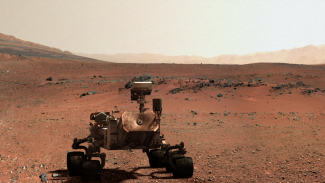INTERVIEW: NASA scientist discusses Curiosity discovery, new TV special

NASA recently released news that its Curiosity rover has found active, organic chemistry on Mars. This is good information for the complicated mission, which is trying to determine whether Mars ever sustained life.
“Organic molecules, which contain carbon and usually hydrogen, are chemical building blocks of life, although they can exist without the presence of life,” NASA reports on its official website. The federal agency added that life on the red planet has not been confirmed, but “the findings do shed light on a chemically active modern Mars and on favorable conditions for life on ancient Mars.”
Today’s Mars is inhospitable to life, but at one time, the climate was more manageable. The working theory is that Gale Crater, where Rover is currently located, was once a lake billions of years ago. The samples were extracted by having Curiosity drill into the mudstone and filter “fine particles” through a sieve.
Dr. Daniel P. Glavin, an astrobiologist with NASA’s Goddard Space Flight Center, has researched organic chemistry and meteorites over the course of his career. He’s one of the chief scientists behind “Sample Analysis at Mars” (SAM), the instrument that measures chemical and isotopic samples from the atmosphere and surface of the red planet. He will be featured in a TV special about Curiosity’s discoveries on Discovery Channel. Red Planet Rover is set to air Thursday, Dec. 18 at 10 p.m.
Recently Hollywood Soapbox exchanged emails with Glavin about Curiosity’s findings and the TV special.
How significant is the recently announced discovery that Curiosity found organics on Mars?
This is a really big discovery for the Curiosity team and a major milestone for Mars science! Scientists have been searching for evidence of organics (the building blocks of life) on Mars for several decades now. Although we can’t yet prove that the organics detected in Gale Crater by Curiosity were created by life, the probability that the ancient lake in Gale Crater could have supported life, just went up.

Could you describe how the technology behind Curiosity works? The layperson might think there are parallels to a remote-controlled car.
The Curiosity rover is exactly that, a remote-controlled car on the surface of Mars that we are operating from Earth, tens of millions of miles away. Every day we talk to the rover by sending commands via two NASA spacecraft currently orbiting Mars which can then relay the message directly to the rover (this is called uplink). After Curiosity completes its activities for the day it sends the data collected back to Earth using one of its three antennas (this is called downlink).
Is the scope of the mission to solely determine whether life once existed on Mars, or are the scientists interested in equally complex questions?
There is no doubt that one of the major goals of this mission is to try to figure out if Gale Crater was habitable, that is to say, having all of the necessary conditions for life: liquid water, energy sources and the organic compounds, the building blocks of life. We always [k]new that proving that life once existed on Mars was going to be an extremely difficult question to answer. However, there are other fundamental questions about Mars that Curiosity will try to answer including how and when the Gale Crater formed and why the lake disappeared.
Curiosity has traveled to the Gale Crater on Mars. Why choose this spot, or did the rover simply land nearby?
The Gale Crater landing site was selected from a list of about 60 possible landing sites on Mars. Beginning in 2006 over a period of five years, Mars scientists from around the world narrowed the list down to four final candidates and the Gale Crater site was selected in 2011. One of the major attractions is that the Gale Crater has a three mile high mountain in the middle of it called Mt. Sharp (about the size of Mt. McKinley) and the detection of clay-rich rock layers on Mt. Sharp from Mars orbiting spacecraft indicated that Gale once contained liquid water, a requirement for life.
What’s next for Curiosity’s adventures?
Over the next couple of years the Curiosity rover is going to climb up Mount Sharp and analyze each layer of exposed rock to try to understand why the climate on Mars changed from a warm, wet and habitable environment to a dry and much less hospitable environment today. We will also of course continue to search for organics and other possible indicators of ancient martian life. The information we will learn at Mt. Sharp is not only important for Mars science, but could also help scientists refine global climate change models to make better predictions about changing conditions on Earth.
By John Soltes / Publisher / John@HollywoodSoapbox.com
-
Red Planet Rover will air Thursday, Dec. 18 at 10 p.m. on Discovery Channel.

